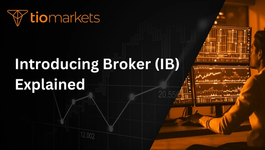Slippage Definition - TIOmarkets
BY TIOmarkets
|June 4, 2024Understanding the concept of slippage is crucial for traders at all levels, especially in the fast-paced world of Forex trading. Slippage occurs when there is a difference between the expected price of a trade and the price at which the trade is executed. This phenomenon can significantly impact trading strategies and outcomes, both positively and negatively.
Understanding Slippage
Slippage is a common occurrence in trading that can affect any order type, not just stop or limit orders. It is essential to grasp the fundamental aspects of slippage to navigate the Forex market effectively.
Causes of Slippage
Several factors contribute to slippage, including market volatility and liquidity. During periods of high volatility, prices can change rapidly, increasing the likelihood of slippage. Similarly, in markets with low liquidity, the available volume at the desired price may not be sufficient, leading to slippage.
Another contributing factor is the speed of execution. Delays between order placement and execution can result in price changes, especially in fast-moving markets.
Types of Slippage
Slippage can be classified into positive and negative slippage. Positive slippage occurs when orders are executed at a better price than expected, while negative slippage happens when orders are executed at a worse price.
Understanding the types of slippage can help traders set realistic expectations and develop strategies to minimize adverse effects.
Impact of Slippage on Trading
The impact of slippage on trading can vary, influencing both the potential profits and losses associated with a trade.
On Profits and Losses
Negative slippage can erode profits or exacerbate losses by executing trades at less favorable prices. Conversely, positive slippage can enhance profitability by securing better prices than anticipated.
Traders must consider the potential for slippage when calculating risk and setting stop-loss orders to protect against significant losses.
Risk Management Strategies
Effective risk management strategies are essential to mitigate the effects of slippage. These include setting appropriate stop-loss orders, monitoring market conditions, and choosing the right times to trade.
Utilizing technology, such as high-speed internet connections and advanced trading platforms, can also reduce the likelihood of slippage by improving order execution speed.
Minimizing Slippage in Forex Trading
While it is impossible to eliminate slippage entirely, there are strategies traders can employ to minimize its impact.
Choosing the Right Broker
Selecting a broker with fast execution speeds and access to deep liquidity pools can help reduce slippage. Brokers that offer "no slippage" or "guaranteed stop loss" orders can provide additional protection, though these options may come with higher costs.
Trading During Peak Hours
Trading during peak market hours when liquidity is highest can decrease the likelihood of slippage. Avoiding major news events, which can cause volatility spikes, is also advisable.
Using Limit Orders
Limit orders allow traders to specify the maximum price they are willing to pay for a buy order or the minimum price for a sell order. This control can prevent negative slippage, though it may result in missed trading opportunities in fast-moving markets.
Additional Strategies to Minimize Slippage
Aside from choosing the right broker, trading during peak hours, and using limit orders, there are other effective strategies to minimize slippage in Forex trading.
One such strategy is to diversify your trading instruments. By spreading your trades across different currency pairs or assets, you can reduce the impact of slippage on any single trade.
Moreover, staying informed about economic events and market developments can help you anticipate potential price movements and adjust your trading strategy accordingly, reducing the risk of slippage.
Additionally, implementing automated trading systems or algorithms can streamline the execution process and minimize the time between order placement and fulfillment, reducing the likelihood of slippage.
Utilizing Advanced Order Types
Advanced order types, such as trailing stops and fill-or-kill orders, can also help minimize slippage by providing more control over trade execution.
Trailing stops automatically adjust the stop-loss level as the trade moves in the trader's favor, locking in profits and reducing the risk of slippage during price retracements.
Fill-or-kill orders require the entire order to be executed immediately or canceled, helping traders avoid partial fills that can lead to slippage.
Conclusion
Slippage is an inherent part of trading that can work both for and against a trader. By understanding its causes and types, traders can better prepare and implement strategies to minimize its impact. Choosing the right broker, trading during peak hours, utilizing limit orders, diversifying trading instruments, staying informed about market events, and using advanced order types are practical steps to reduce slippage and enhance trading outcomes.
At TIOmarkets, we are committed to providing our clients with the tools and knowledge to navigate the complexities of Forex trading, including managing slippage effectively. Our platform is designed to offer fast execution speeds and access to deep liquidity, helping you to maximize your trading potential.
Start Trading with Precision at TIOmarkets
Ready to take control of your trading experience and minimize slippage? Join over 170,000 traders across 170 countries who have chosen TIOmarkets for our fast execution speeds and deep liquidity. With access to over 300 instruments across 5 markets, including Forex, indices, stocks, commodities, and futures, you'll trade with low fees and the support of our comprehensive educational resources. Create a Trading Account today and harness the full potential of your trading strategies with TIOmarkets.

Risk disclaimer: CFDs are complex instruments and come with a high risk of losing money rapidly due to leverage. You should consider whether you understand how CFDs work and whether you can afford to take the high risk of losing your money. Never deposit more than you are prepared to lose. Professional client’s losses can exceed their deposit. Please see our risk warning policy and seek independent professional advice if you do not fully understand. This information is not directed or intended for distribution to or use by residents of certain countries/jurisdictions including, but not limited to, USA & OFAC. The Company holds the right to alter the aforementioned list of countries at its own discretion.
Join us on social media

Behind every blog post lies the combined experience of the people working at TIOmarkets. We are a team of dedicated industry professionals and financial markets enthusiasts committed to providing you with trading education and financial markets commentary. Our goal is to help empower you with the knowledge you need to trade in the markets effectively.





